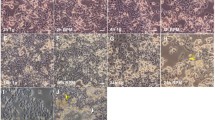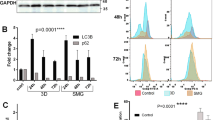Abstract
Neuroblastoma, the most common and deadly solid pediatric tumor, features genetic and biologic heterogeneity that defies simple risk assessments, drives diverse clinical behavior, and demands more extensive characterization. This research served to investigate the utility of a microgravity assay—rotary bioreactor culture—to evaluate and characterize the cell-specific, in vitro behavior of neuroblastoma cell lines: aggregation kinetics of single cells and the morphology of the formed structures, called organoids. Specifically, we examined the effect of amplification of the oncogene MYCN, a genetic factor that is strongly associated with poor clinical outcome. Three human neuroblastoma cell lines with varied MYCN expression (CHP-212 (unamplified), SK-N-AS (unamplified), IMR-32 (amplified)) were cultured in the microgravity rotary bioreactor. Simple aggregation kinetics were determined by periodically performing counts of non-aggregated single cells in the media. Organoids were harvested, stained with hematoxylin and eosin, and evaluated microscopically in terms of size and shape. The MYCN-amplified cell line (IMR32) aggregated much more rapidly than the unamplified cell lines, as indicated by a significantly lower area under its aggregation curve (single non-aggregated cells vs. time): IMR32 = 4.3, CHP-212 =12.4, SK-N-AS = 9.8 (adhesion index ×105). Further, the organoid morphology of the MYCN-amplified cell line was noticeably different compared to the unamplified lines. The CHP-212 and SK-N-AS cells formed spherical structures with average cross-sectional area 0.213 and 0.138 mm2, respectively, and featured an outer viable zone of cells (average length of 0.175, 0.129 mm, respectively; the “diffusion distance”), surrounding an inner necrotic core. In contrast, the MYCN-amplified cell line formed a large single mass of cells but had a similar diffusion distance (0.175 mm). This microgravity assay provides a rapid, reproducible assessment of in vitro behavior of neuroblastoma, and the measured parameters, aggregation kinetics and organoid size and shape correlated with malignant potential in terms of MYCN amplification. This assay allows for the examination of cell-specific biologic and genetic factors that should provide valuable insight into the clinical behavior of neuroblastoma.







Similar content being viewed by others
References
Brodeur G. M. Neuroblastoma: biological insights into a clinical enigma. Nat. Rev. Cancer 3: 203–216; 2003.
Brodeur G. M.; Seeger R. C.; Schwab M.; Varmus H. E.; Bishop J. M. Amplification of N-myc sequences in primary human neuroblastomas: correlation with advanced disease stage. Prog. Clin. Biol. Res. 175: 105–13; 1985.
Chen C. S.; Mrksich M.; Huang S.; Whitesides G. M.; Ingber D. E. Geometric control of cell life and death. Science 276: 1425–8; 1997.
Cherry R. S.; Papoutsakis E. T. Hydrodynamic effects on cells in agitated culture reactors. Bioprocess. Eng. 1: 29–41; 1986.
Doolin E. J.; Geldziler B.; Strande L.; Kain M.; Hewitt C. W. Effects of microgravity on growing cultured skin constructs. Tissue Eng. 5: 573–582; 1999.
Fan L.; Iyer J.; Zhu S.; Frick K. K.; Wada R. K.; Eskenazi A. E.; Berg P. E.; Ikegaki N.; Kennett R. H.; Frantz C. N. Inhibition of N-myc expression and induction of apoptosis by iron chelation in human neuroblastoma cells. Cancer Res. 61: 1073–9; 2001.
Folkman J.; Greenspan H. P. Influence of geometry on control of cell growth. Biochim. Biophys. Acta 417: 211–236; 1975.
Freed L. E.; Vunjak-Novakovic G. Microgravity tissue engineering. In Vitro Cell. Dev. Biol. Anim. 33: 381–385; 1997.
Goodwin T. J.; Prewett T. L.; Wolf D. A.; Spaulding G. F. Reduced shear stress: a major component in the ability of mammalian tissues to form three-dimensional assemblies in simulated microgravity. J. Cell. Biochem. 51: 301–311; 1993.
Hewitt C. W.; Kain M.; Strande L.; Puc M.; Tran H.; DelRossi A. J.; Doolin E. J. A novel rejection model using a microgravity based 3D cell culture system. Cell Transpl. Soc. 8: 196; 1999.
Ingram M.; Techy G. B.; Saroufeem R.; Yazan O.; Narayan K. S.; Goodwin T. J.; Spaulding G. F. Three-dimensional growth patterns of various human tumor cell lines in simulated microgravity of a NASA bioreactor. In Vitro Cell. Dev. Biol. Anim. 33: 459–66; 1997.
Iyer R.; Evans A. E.; Qi X.; Ho R.; Minturn J. E.; Zhao H.; Balamuth N.; Maris J. M.; Brodeur G. M. Lestaurtinib enhances the antitumor efficacy of chemotherapy in murine xenograft models of neuroblastoma. Clin. Cancer Res. 16: 1478–85; 2010.
Jessup J. M.; Goodwin T. J.; Spaulding G. F. Prospects for use of microgravity-based bioreactors to study three-dimensional host-tumor interactions in human neoplasia. J. Cell. Biochem. 51: 290–300; 1993.
Licato L. L.; Prieto V. G.; Grimm E. A. A novel preclinical model of human malignant melanoma utilizing bioreactor rotating-wall vessels. In Vitro Cell. Dev. Biol. Anim. 37: 121–126; 2001.
Maris J. M. The biologic basis for neuroblastoma heterogeneity and risk stratification. Curr. Opin. Pediatr. 17: 7–13; 2005.
O’Connor K. C. Three-dimensional cultures of prostatic cells: tissue models for the development of novel anti-cancer therapies. Pharm. Res. 16: 486–493; 1999.
Rhee H. W.; Zhau H. E.; Pathak S.; Multani A. S.; Pennanen S.; Visakorpi T.; Chung L. W. K. Permanent phenotypic and genotypic changes of prostate cancer cells cultured in a three-dimensional rotating-wall vessel. In Vitro Cell. Dev. Biol. Anim. 37: 127–140; 2001.
Schwartz R. P.; Goodwin T. J.; Wolf D. A. Cell culture for three-dimensional modeling in rotating-wall vessels: an application of simulated microgravity. J. Tissue Cult. Methods 14: 51–57; 1992.
Tonelli R.; Purgato S.; Camerin C.; Fronza R.; Bologna F.; Alboresi S.; Franzoni M.; Corradini R.; Sforza S.; Faccini A.; Shohet J. M.; Marchelli R.; Pession A. Anti-gene peptide nucleic acid specifically inhibits MYCN expression in human neuroblastoma cells leading to cell growth inhibition and apoptosis. Mol. Cancer Ther. 4: 779–86; 2005.
Tsao Y. D.; Goodwin T. J.; Wolf D. A.; Spaulding G. F. Responses of gravity level variations on the NASA/JSC bioreactor system. Physiologist 35: 49–50; 1991.
Vamvakidou A. P.; Mondrinos M. J.; Petushi S. P.; Garcia F. U.; Lelkes P. I.; Tozeren A. Heterogeneous breast tumoroids: an in vitro assay for investigating cellular heterogeneity and drug delivery. J. Biomol. Screen. 12: 13–20; 2007.
Van Noesel M. M.; Versteeg R. Pediatric neuroblastoma: genetic and epigenetic ‘Danse Macabre’. Gene 325: 1–15; 2004.
Author information
Authors and Affiliations
Corresponding author
Additional information
Editor: J. Denry Sato
Rights and permissions
About this article
Cite this article
Redden, R.A., Doolin, E.J. Microgravity assay of neuroblastoma: in vitro aggregation kinetics and organoid morphology correlate with MYCN expression. In Vitro Cell.Dev.Biol.-Animal 47, 312–317 (2011). https://doi.org/10.1007/s11626-011-9393-8
Received:
Accepted:
Published:
Issue Date:
DOI: https://doi.org/10.1007/s11626-011-9393-8




